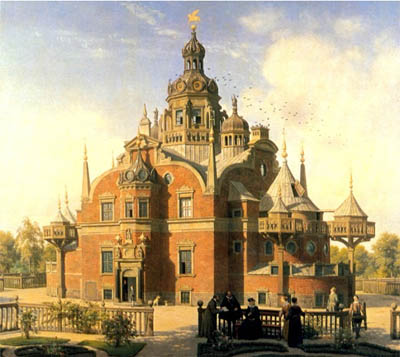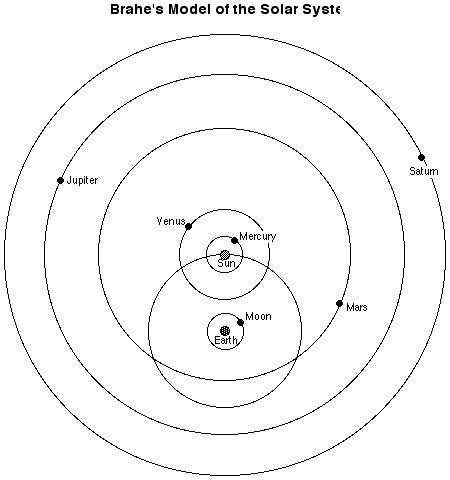
Born in Knudstrup, Denmark
- Most accurate naked-eye astronomical observations in history.
- Proves comets and a supernova are celestial bodies.
- Tychonic model of the solar system.

Tycho was born into Danish nobility, and was actually raised by his uncle, though no one really knows why. He ends up attending the University of Copenhagen in 1559, and about a year later there was a predicted solar eclipse that got him interested and excited in astronomy. He begins to purchase astronomical texts and instruments and begins making his own observations. It becomes apparent early on that existing tables just weren't that accurate, whether they were made from Ptolemy's model or Copernicus'. He decides he can do better.
Tycho was outgoing and thought highly of himself. In 1566, he gets in an argument with another student over who was the better mathematician which they tried to resolve by having a duel. I don't know what happened to the other student, but Tycho had the end of nose cut off, and he ends up getting a prosthetic made.
Around 1570, Tycho sets up his own little observatory and laboratory on family land and begins doing astronomy. 1572 was a good year for Tycho. First he met a girl who would become his common-law wife (they could never legally marry because he was nobility and she was not) and second, a new star appears in the constellation of Cassiopeia. (Reality was that a long time ago, a star blew up, and the light from that explosion finally got to the earth in 1572.) His observations, and subsequent travels, give Tycho a very good reputation. He is ready to leave Denmark when King offers him the island of Hven and sizable support to set up the premier observatory of his time.
Tycho was dismayed that one couldn't tell which astronomical model was correct. He didn't like the equant and he didn't like a moving earth, and neither the Copernican or Ptolemeic model worked any better than the other. The Copernican model was prettier, but didn't seem to work any better than the Ptolemaic. He also quickly realized that the astronomical tables and data availabel at the time just wasn't that accurate. He realizes that if he is going to figure out what is correct and really happening up in the sky, he was going to have to take his own data, and be very careful and as accurate as possible. So he learns about astronomical instruments, and sets up his own little observatory in the back yard, so to speak.
 In 1572, a new star suddenly appeared in the constellation of Cassiopeia. It was noted all over the world. Tycho was one of many people who observed it; over the next few weeks, it got brighter and brighter, eventually it was possible to see it in the daytime, and then it slowly faded from view. In all, it was visible for about a year and a half. Tycho had set up an observatory in the back year and made careful observations over this time period, and he published his results in a little book called De Stella Nova, or the New Star. (The picture to the left is from this book - the new star is the big one at the top.) In it, he showed how there was no measurable parralax, and so it had to be farther than the moon. This is important because people still clung to the notion that the heavens were perfect and unchanging - and well, this was a big and sudden change. (People would have argued that anything new was simply up in the atmosphere, and so really a part of the earth.) This book also helped to give Tycho a reputation as a talented astronomer.
In 1572, a new star suddenly appeared in the constellation of Cassiopeia. It was noted all over the world. Tycho was one of many people who observed it; over the next few weeks, it got brighter and brighter, eventually it was possible to see it in the daytime, and then it slowly faded from view. In all, it was visible for about a year and a half. Tycho had set up an observatory in the back year and made careful observations over this time period, and he published his results in a little book called De Stella Nova, or the New Star. (The picture to the left is from this book - the new star is the big one at the top.) In it, he showed how there was no measurable parralax, and so it had to be farther than the moon. This is important because people still clung to the notion that the heavens were perfect and unchanging - and well, this was a big and sudden change. (People would have argued that anything new was simply up in the atmosphere, and so really a part of the earth.) This book also helped to give Tycho a reputation as a talented astronomer.
Soon after, the king of Denmark gives Brahe the island of Hven to run as a his own feudal estate. On this island, he builds a castle/observatory called Uraniborg (picture to the right), and by 1576 Tycho is running the largest scientific enterprise in the world at that time.  He is truly gifted in making and astronomical insturments that can measure celestial positions with an accuracy up to only a couple minutes of arc. In 1584, he builds a second observatory called Stjerneborg, for even more accurate measurements. (Basically, it was more windproof and solid.) He proceeds to take systematic, and highly accurate, observations of the stars and planets for over 20 years. In 1597, the new king of Denmark finally ends his support of Uraniborg, and Tycho eventually moves to Prague after getting appointed the Imperial Mathematican to Emprorer Rudolph II.
He is truly gifted in making and astronomical insturments that can measure celestial positions with an accuracy up to only a couple minutes of arc. In 1584, he builds a second observatory called Stjerneborg, for even more accurate measurements. (Basically, it was more windproof and solid.) He proceeds to take systematic, and highly accurate, observations of the stars and planets for over 20 years. In 1597, the new king of Denmark finally ends his support of Uraniborg, and Tycho eventually moves to Prague after getting appointed the Imperial Mathematican to Emprorer Rudolph II.
In 1577, a comet appears that Brahe is able to show is also beyond the orbit of the moon and so is also a celestial event. Yet again, there is something new and changing in the heavens.
In 1588, Tycho proposes a hybrid model of the solar system. (See image below.) He thinks he has found the answer to what is going on up in the sky. It combines the beautiful "scale" of the Copernican model with a stationary earth. He proposes that the earth is at rest in the middle of the universe. The moon obviously goes around the earth and so does the sun and the stars. All the other planets, however, go around the sun. He never actually works out any mathematical details, as he can never quite get it right. Mars is particularly difficult to reconcile and make fit.

Try as he might, Brahe just wasn't a good enough mathematician to make his model work, or for that matter, to show that either Ptolemy or Copernicus was right or wrong. In 1596, Kepler had sent Brahe a copy of his first little book "The Cosmographic Secret" and Brahe was so impressed he tried to get Kepler to join him in Denmark. Kepler declined, as that was too far away. As luck would have it, in 1597 the new king of Denmark kicks Brahe out, and Brahe ends up the Imperial Mathematician to Emporer Rudolph II in Prague in 1598. Kepler was also kicked out of Graz by then, and ends up joining Brahe in Prague in 1600. Brahe is hopeful that Kepler will be able to help him prove his own model correct.
Kepler and Brahe did not get along, and had a very stormy relationship. Kepler was the more gifted mathematician, but Brahe had the data. Brahe pointed out to Kepler that Mars was the planet that was the most challenging to figure out, but he never gave Kepler full access to the data. This goes on for a little over a year when Brahe suddenly falls ill, and dies, either from a urinary tract infection or his own home remedy which may have contained a lot of mercury. On Brahe's death bed, he is said to have whispered over and over to Kepler, "Let me not to have died in vain."
After Brahe's death, Kepler gets all of Brahe's data (but not without controversy) and is able to eventually figure out the true nature of the orbits of the planets only because of the extreme accuracy of Brahe's data. In the end, it was Brahe's data that was his greatest legacy, and not his astronomical model. In fact, to this day, his data remains the most accurate astronomical data ever taken without the use of a telescope. In 1611, Galileo uses a telescope to make astronomical observations, and a new age in astronomy begins.